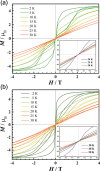Thermally Stable Terbium(II) and Dysprosium(II) Bis-amidinate Complexes
- PMID: 37997752
- PMCID: PMC10755703
- DOI: 10.1021/jacs.3c07978
Thermally Stable Terbium(II) and Dysprosium(II) Bis-amidinate Complexes
Abstract
The thermostable four-coordinate divalent lanthanide (Ln) bis-amidinate complexes [Ln(Piso)2] (Ln = Tb, Dy; Piso = {(NDipp)2CtBu}, Dipp = C6H3iPr2-2,6) were prepared by the reduction of parent five-coordinate Ln(III) precursors [Ln(Piso)2I] (Ln = Tb, Dy) with KC8; halide abstraction of [Ln(Piso)2I] with [H(SiEt3)2][B(C6F5)] gave the respective Ln(III) complexes [Ln(Piso)2][B(C6F5)]. All complexes were characterized by X-ray diffraction, ICP-MS, elemental analysis, SQUID magnetometry, UV-vis-NIR, ATR-IR, NMR, and EPR spectroscopy and ab initio CASSCF-SO calculations. These data consistently show that [Ln(Piso)2] formally exhibit Ln(II) centers with 4fn5dz21 (Ln = Tb, n = 8; Dy, n = 9) valence electron configurations. We show that simple assignments of the f-d coupling to either L-S or J-s schemes are an oversimplification, especially in the presence of significant crystal field splitting. The coordination geometry of [Ln(Piso)2] is intermediate between square planar and tetrahedral. Projecting from the quaternary carbon atoms of the CN2 ligand backbones shows near-linear C···Ln···C arrangements. This results in strong axial ligand fields to give effective energy barriers to magnetic reversal of 1920(91) K for the Tb(II) analogue and 1964(48) K for Dy(II), the highest values observed for mononuclear Ln(II) single-molecule magnets, eclipsing 1738 K for [Tb(C5iPr5)2]. We tentatively attribute the fast zero-field magnetic relaxation for these complexes at low temperatures to transverse fields, resulting in considerable mixing of mJ states.
Conflict of interest statement
The authors declare no competing financial interest.
Figures








Similar articles
-
Rare earth benzene tetraanion-bridged amidinate complexes.Chem Sci. 2024 Dec 17;16(4):1907-1924. doi: 10.1039/d4sc05982d. eCollection 2025 Jan 22. Chem Sci. 2024. PMID: 39722786 Free PMC article.
-
Synthesis and Magnetism of Neutral, Linear Metallocene Complexes of Terbium(II) and Dysprosium(II).J Am Chem Soc. 2019 Aug 21;141(33):12967-12973. doi: 10.1021/jacs.9b05816. Epub 2019 Aug 12. J Am Chem Soc. 2019. PMID: 31375028
-
Syntheses, structures, and magnetic properties of acetato- and diphenolato-bridged 3d-4f binuclear complexes [M(3-MeOsaltn)(MeOH)x(ac)Ln(hfac)2] (M = Zn(II), Cu(II), Ni(II), Co(II); Ln = La(III), Gd(III), Tb(III), Dy(III); 3-MeOsaltn = N,N'-bis(3-methoxy-2-oxybenzylidene)-1,3-propanediaminato; ac = acetato; hfac = hexafluoroacetylacetonato; x = 0 or 1).Inorg Chem. 2013 May 20;52(10):6160-78. doi: 10.1021/ic400594u. Epub 2013 May 6. Inorg Chem. 2013. PMID: 23646986
-
Synthesis, structure, luminescent, and magnetic properties of carbonato-bridged Zn(II)2Ln(III)2 complexes [(μ4-CO3)2{Zn(II)L(n)Ln(III)(NO3)}2] (Ln(III) = Gd(III), Tb(III), Dy(III); L(1) = N,N'-bis(3-methoxy-2-oxybenzylidene)-1,3-propanediaminato, L(2) = N,N'-bis(3-ethoxy-2-oxybenzylidene)-1,3-propanediaminato).Inorg Chem. 2013 Nov 4;52(21):12828-41. doi: 10.1021/ic4022273. Epub 2013 Oct 23. Inorg Chem. 2013. PMID: 24151881
-
Asymmetric Dinuclear Lanthanide(III) Complexes from the Use of a Ligand Derived from 2-Acetylpyridine and Picolinoylhydrazide: Synthetic, Structural and Magnetic Studies.Molecules. 2020 Jul 10;25(14):3153. doi: 10.3390/molecules25143153. Molecules. 2020. PMID: 32664199 Free PMC article.
Cited by
-
A comprehensive approach for elucidating the interplay between 4f n+1 and 4f n 5d1 configurations in Ln2+ complexes.Chem Sci. 2025 Jan 3;16(4):2024-2033. doi: 10.1039/d4sc05438e. eCollection 2025 Jan 22. Chem Sci. 2025. PMID: 39759928 Free PMC article.
-
Guanidinate Yttrium Complexes Containing Bipyridyl and Bis(benzimidazolyl) Radicals.Inorg Chem. 2024 May 27;63(21):9659-9669. doi: 10.1021/acs.inorgchem.4c00006. Epub 2024 Apr 3. Inorg Chem. 2024. PMID: 38569134 Free PMC article.
-
Rare earth benzene tetraanion-bridged amidinate complexes.Chem Sci. 2024 Dec 17;16(4):1907-1924. doi: 10.1039/d4sc05982d. eCollection 2025 Jan 22. Chem Sci. 2024. PMID: 39722786 Free PMC article.
-
δ-Bonding modulates the electronic structure of formally divalent nd1 rare earth arene complexes.Chem Sci. 2024 Aug 5;15(37):15160-9. doi: 10.1039/d4sc03005b. Online ahead of print. Chem Sci. 2024. PMID: 39220159 Free PMC article.
-
Supramolecular assemblies of tetravalent terbium complex units: syntheses, structure, and materials properties.Chem Sci. 2025 Mar 11;16(16):6805-6811. doi: 10.1039/d4sc08731c. eCollection 2025 Apr 16. Chem Sci. 2025. PMID: 40110526 Free PMC article.
References
-
- The Lanthanides and Actinides; Liddle S. T.; Mills D. P.; Natrajan L. S., Eds.; World Scientific Publishing Europe Ltd.: Singapore, 2022.
LinkOut - more resources
Full Text Sources
Research Materials
Miscellaneous

